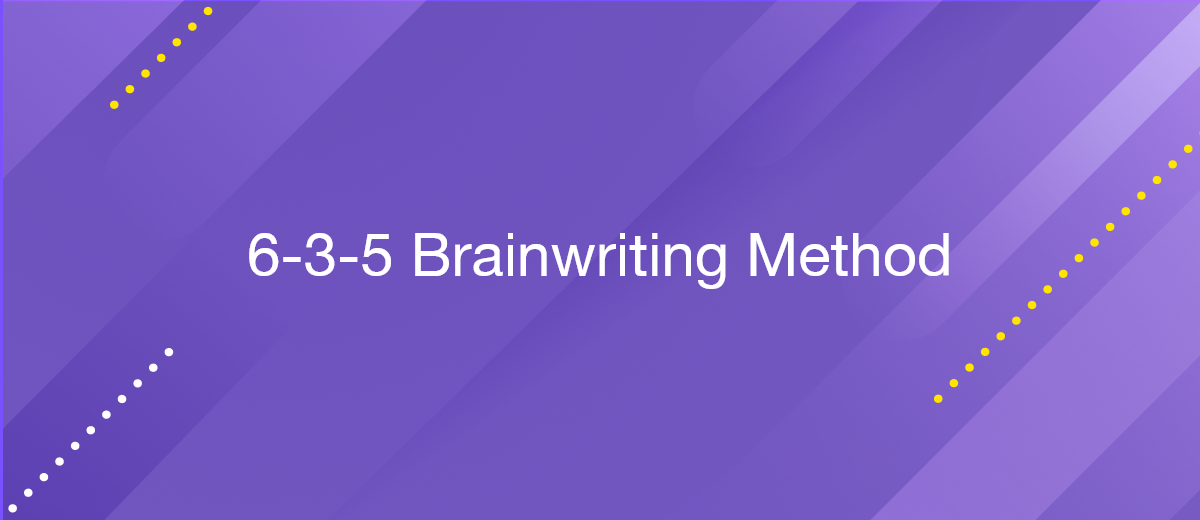What is the 6-3-5 Brainwriting Method and How to Use It to Generate Unique Ideas?
Many professionals assume that brainstorming is the most efficient method when it comes to generating ideas. However, this isn't set in stone! In fact, brainstorming comes with its fair share of downsides that can seriously impact your team's performance. Now, did you think we'd leave you without alternatives? Of course not! There are plenty of creative ways to come up with ideas and solve corporate problems, such as crowdsourcing, 6-3-5 brainwriting, mind mapping.
Wait—what is the 6-3-5 brainwriting method? Well, you're in the right spot because that's what we'll break down today. By the end of this post, you'll know exactly when and how to use this collaborative method, but until then, grab your favorite drink, settle in and enjoy the read.
What is the 6-3-5 Brainwriting Method?
If you've Googled brainwriting, you've probably come across a bunch of jargon that wasn't relevant to your search. To make your life a bit easier, let’s introduce this method in the simplest way possible 👇
The 6-3-5 Brainwriting Method is a structured brainstorming technique created in the 1960s to help teams generate a large number of ideas without the usual slowdowns of traditional brainstorming sessions.
Where does the 6-3-5 name come from, you ask? Well, here is the explanation 👇
- 6 participants involved
- 3 ideas per person
- 5-minute rounds
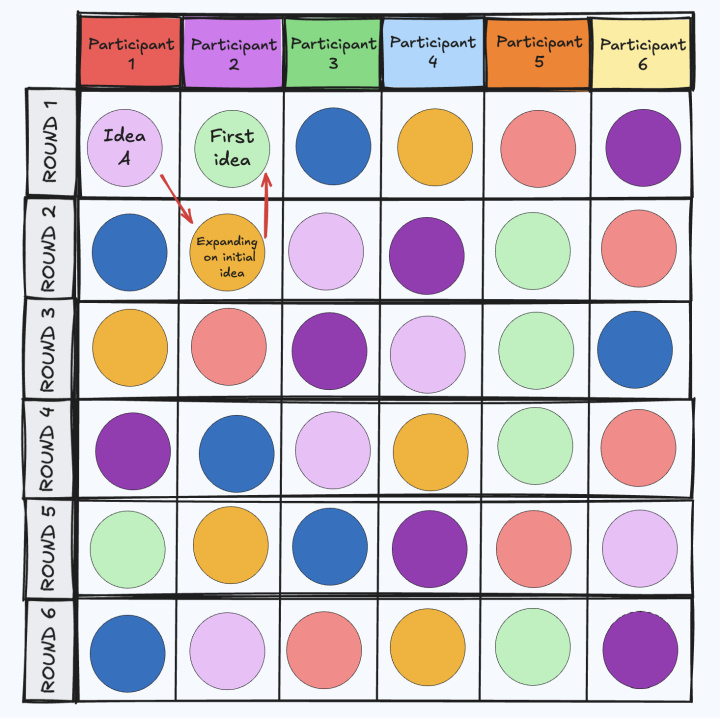
Each participant writes down three ideas on a specific topic or project. After 5 minutes, they pass their sheet to the next person, who builds on the ideas or comes up with a new one. By the end of the session, you'll have 90 ideas. Yeah, you heard that right! (6 participants × 3 ideas × 5 rounds = 90).
What are the Takeaways of Brainwriting?
Brainwriting is one of the most productive collaborative methods, and creativity is the name of the game!
This technique is not just innovative, but also super democratic, and that's exactly what we'll discuss below. So let's get into brainwriting benefits one by one 👇
Inclusive collaboration method
Because it relies on written contributions (yes, good old-fashioned pen and paper!) Brainwriting can help bring together all team members, regardless of their backgrounds and working styles.
Got some introverts on your team? No problem—this method is the one-stop solution for them. It lets them share their ideas without having to speak up in front of everyone 👌🏻
Equal team input
We know we will get some heat for saying this: "With brainstorming, dominant personalities often end up monopolizing the discussion". Sure, sometimes that's not the case, but it's definitely the exception and not the rule.
And this is where brainwriting helps out—it encourages equal participation and gives every team member a fair chance to contribute their ideas to the process.
Stimulates creative thinking
In a perfect brainwriting session, everyone starts by working independently before sharing their ideas. The takeaway from this? It lets everyone come up with original, unbiased ideas—free from the influence of the loudest voices in the room.
- Automate the work of an online store or landing
- Empower through integration
- Don't spend money on programmers and integrators
- Save time by automating routine tasks
90 ideas or more
Does brainwriting get any better than that? And the answer is, yes, it does! Here's how: since the brainwriting structure is time-bound, it pushes participants to generate a high volume of ideas in a short amount of time.
And as we explained in the definition, with six participants and 5-minute rounds, the whole session lasts just 30 minutes. By the end, you’ll have about 90 ideas (sometimes more) with less time wasted on counterproductive tangents.
Problem-solving approach
Saved the best for last!
Brainwriting isn't just about generating ideas; it really solves problems, and we mean very complex problems. The input from multiple perspectives is powerful enough to help teams identify pain points and find real solutions.
Want a real-life example? 3M, the giant US manufacturing company, has a similar approach called the "15% Rule," where employees can spend 15% of their time on projects outside their regular duties. The end result of all this? The company invented iconic products like Post-it Notes and Scotch Tape.
The Main Differences Between Brainwriting and Brainstorming
Now that we have established what brainwriting is and why it's beneficial for your team to perform it, some of you are probably thinking, "What's the difference between brainwriting and brainstorming?"
Well, that’s what we are here for! Let’s clear that up.
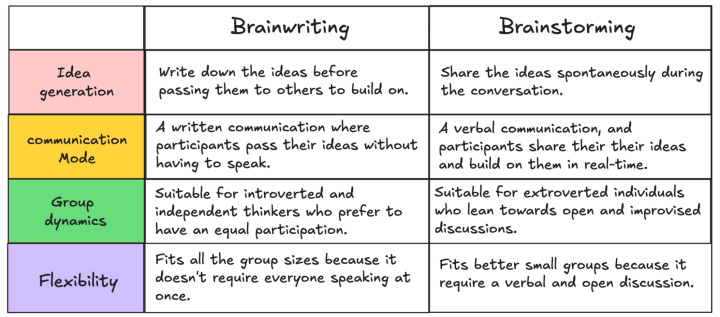
Idea generation
In the brainwriting method, participants write down their ideas first and then pass them along for others to build on. Once all the ideas are collected, the team can start sharing and discussing the session responses.
But with brainstorming, the process is quite different—ideas are shared spontaneously during the conversation, often with little to no time for them to develop before being interrupted or critiqued.
Of course, some teams might customize their brainstorming, but this is how most brainstorming sessions typically run.
Communication mode
Another key difference between these two methods is how communication happens, and it's not hard to see why!
In brainwriting, communication is written rather than verbal, so participants jot down their ideas and pass them on to others without having to speak up in front of a group. On the other hand, in the brainstorming approach, the communication is verbal and open. Participants share ideas right away and build on each other's ideas in real time, which triggers immediate feedback and exchanges.
Even better! The brainwriting method can even be adapted for virtual sessions using social media platforms, where participants could share ideas privately via direct messages to keep the session focused and productive.
Group dynamics
Are you reserved or more of an extroverted person? The reason we are asking this is because each method works best for different personalities.
If you value equal participation and prefer thinking independently, brainwriting is probably your go-to technique, as it fits better with that style. On the opposite end of the spectrum, if you're outgoing and enjoy open discussions, brainstorming will likely feel more natural (and productive) for you.
Flexibility
Last but not least, we've got to talk about flexibility—another important difference between the two methods.
Brainwriting is suitable for all groups regardless of their size because, as we've mentioned, it doesn't require everyone to speak at once. Unlike brainstorming, which can get messy and less efficient in bigger groups due to its verbal nature.
Real-World Brainwriting Use Cases
We know, we know, you definitely need some more help to understand how brainwriting functions, so let's paint a clearer picture with a real-world use case. But first, the scenario!
Let’s assume, for instance, that a software development team might decide on which project management method to use. The team members would conduct a brainstorming session to choose the most effective method for tracking and organizing their tasks throughout the project.
So, as we've discussed earlier, the brainwriting setup will include:
- 6 Participants from developers, a project manager, and a designer.
- 6 rounds, 5 minutes each.
- Each participant will contribute three ideas per round.
Round 1
Each participant writes down three suggested ideas:
- Participant 1: We can use the Kanban method to track daily tasks, integrate it with Jira, and visualize tasks with swimlanes.
- Participant 2: I suggest using Gantt charts with Paymo for better timeline management. Better yet, we can even share visual updates with clients and highlight dependencies in red.
- Participant 3: I'd create a Project Network Diagram for tracking task dependencies. It's very efficient for preventing bottlenecks and automating task assignments.
- Participant 4: For sprints, we can combine Gantt charts with Kanban, opt for Trello for a more simplistic use, and set deadlines within tasks.
- Participant 5: We can use Kanban for real-time updates, Gantt charts for quarterly goals, and network diagrams for development phases.
- Participant 6: I’d suggest automating Kanban board updates via Slack, using network diagrams for backend planning, and Gantt for the team calendar.
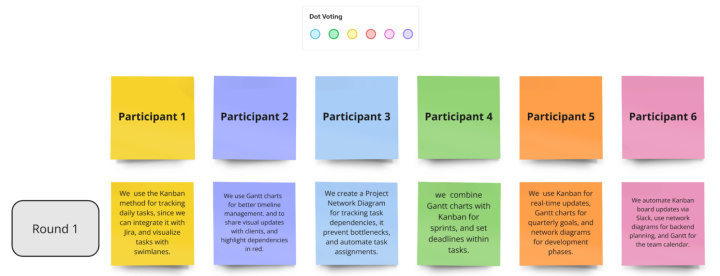
Round 2
Team members will start refining their ideas passed from others:
- Participant 1: We can add color codes to Gantt charts for urgent tasks.
- Participant 2: It would be great if we could integrate Kanban boards with GitHub for live status updates.
- Participant 3: We might need to use Kanban swimlanes for front vs. backend tasks.
- Participant 4: It would be great if we visualize milestones in Gantt charts for executive summaries.
- Participant 5: The selling point of Network diagrams is that they can help visualize cross-team dependencies.
- Participant 6: We can also track time spent per task in Kanban to evaluate sprints.
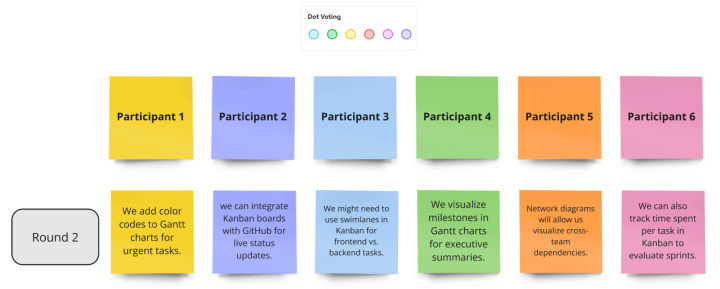
Round 3
The team members will discuss the potential combinations and tools they can use:
- Participant 1: Why not use Kanban for developers and Gantt charts for stakeholders?
- Participant 2: Network diagrams will also allow us to visualize parallel workflows.
- Participant 3: We can even combine Kanban with Agile metrics like velocity tracking.
- Participant 4: Automate Gantt chart updates with a task management software.
- Participant 5: Share network diagrams during planning only.
- Participant 6: We can customize Kanban cards with priority tags.
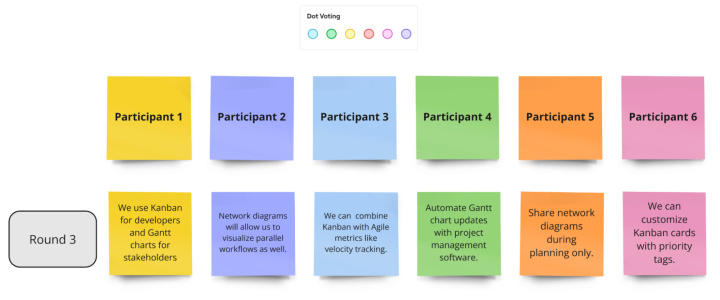
Round 4
In this round, each participant will suggest solutions to the potential issues they might face down the line:
- Participant 1: We might use automation tools like ApiX-Drive.
- Participant 2: We have to make sure Kanban boards are not overloaded by setting WIP limits.
- Participant 3: We must keep track of network diagrams regularly to avoid outdated dependencies.
- Participant 4: We should simplify Gantt charts for team members who aren't familiar with them.
- Participant 5: We can schedule Kanban updates during daily standups.
- Participant 6: I suggest using ready-to-use templates for network diagrams to save time.
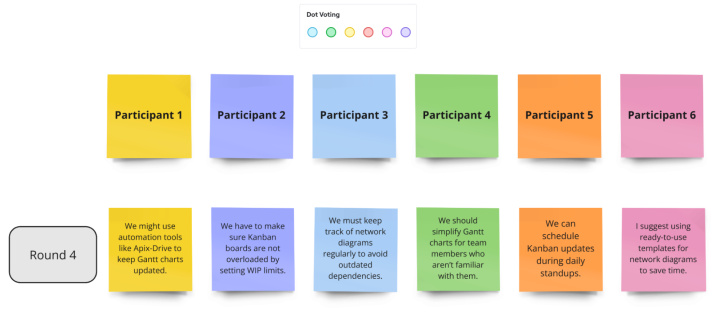
Round 5
In the fifth round, participants will pick and fine-tune the best ideas:
- Participant 1: Let’s use Kanban boards for sprints and link to a shared Gantt chart.
- Participant 2: We should automate task dependencies in network diagrams with software.
- Participant 3: We mark task delays with Kanban board alerts.
- Participant 4: We will choose Gantt charts for long-term planning and keep them simple.
- Participant 5: We assign Kanban swimlanes to specific teams in the project.
- Participant 6: We visualize overlapping tasks with network diagrams.
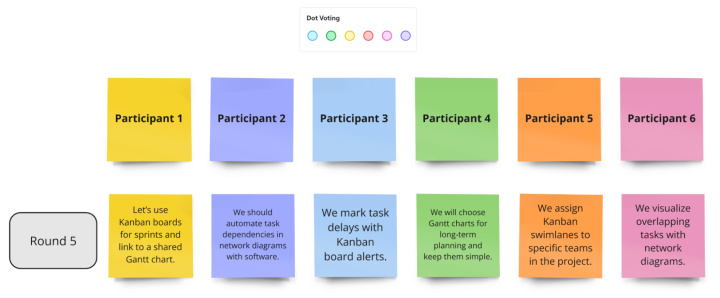
Round 6
Now that the team has come up with various ideas. The brainwriting session organizer will narrow it down to this flexible approach:
Primary Tool:
- Kanban board for daily updates and sprint management.
Secondary Tools:
- Gantt charts for client-facing timelines and high-level planning.
- Network diagrams for mapping dependencies during the planning phase.

Here is how the brainwriting board will look like with all the rounds and ideas 👇
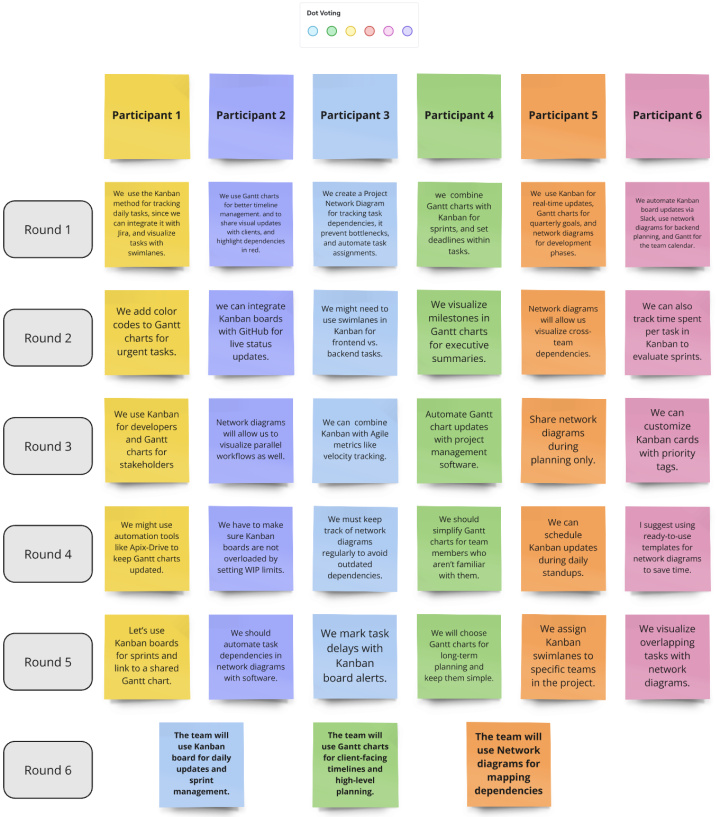
Final Words from ApiX-Drive
We think by now, one thing is clear. Brainwriting is a method too cool for you to ignore. Depending upon your needs, you can set up brainwriting sessions for your team and even automate parts of the process—and it's not as tough as you think.
ApiX-Drive is one tool that can help you connect different apps like Notion, Google Sheets, Asana, and Slack, making it a no-sweat for your team to exchange and build on the 90 ideas 😉
Want to learn even more about how to automate brainwriting? Head to our 👉🏻 blog for more insights.
Thanks for sticking with us! We hope this helps supercharge your idea generation—let us know what you try out! 🚀
